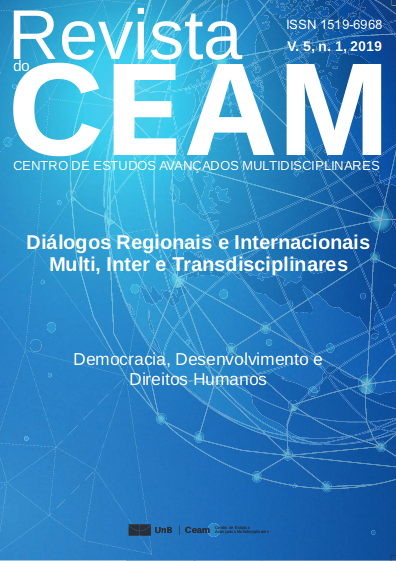Latin America in the face of growing tension between China and the U.S.
Where is the world going?
DOI:
https://doi.org/10.5281/zenodo.3251498Keywords:
China, Decline hegemony, Latin America, United States, World GeopoliticsAbstract
This article argues that a structural change is occurring in the international order, signalled by the decline of US hegemony. This decline began in the nineteen-seventies and has been accentuated so far in this twenty-first century, as a result of the rise of China as a first-order global power. The arrival of Donald Trump as President of the United States is a manifestation of this structural phenomenon. The attempt to halt and reverse this decline in US hegemony explains Trump's protectionist economic policies, as well as the growing tension between China and the US. This scenario must be deeply evaluated in Latin America, because, while its economy is increasingly dependent on the Chinese market, the US, on the other hand, still sees this region as its "backyard".
Downloads
References
ARRIGHI, Giovanni. Marxist Century, American Century: The Making and Remaking of the World Labour Movement. New Left Review, n. 179, january-february 1990, p. 29-63.
BANCO Mundial, BM. PIB (US$ a precios actuales). Web. 12 de marzo de 2018. <https://datos.bancomundial.org/indicador/ny.gdp.mktp.cd>.
BARRIOS, Miguel, Ángel. Consejo Suramericano de defensa: desafíos geopolíticos y perspectivas continentales. Buenos Aires: Biblos, 2011.
BORON, Atilio A. América Latina en la Geopoliítica del Imperialismo. Caracas: Ministerio del Poder Popular para la Cultura, 2013.
BRAUDEL, Fernand. El Mediterráneo y el mundo mediterráneo en la época de Felipe II. Madrid: Fondo de Cultura Económica, 1976.
BRUCKMANN, Mónica. Recursos Naturales y la Geopolítica de la Integración Sudamericana. Quito: Editorial IAEN, 2012.
BRUZZONE, Elsa. Las Guerras del Agua. Buenos Aires: Capital Intelectual, 2009.
BRZEZINSKI, Zbigniew. El Dilema de EE.UU. ¿Dominación global o liderazgo mundial? Barcelona: Paidos, 2005.
CASTELLS, Manuel. La era de la información. Economía, sociedad y cultura. La Sociedad Red. México: Siglo XXI 1996.
CENTRAL Intelligence Agency (CIA). Country ComParíson: GDP (purchasing power parity). Web. 6 de marzo de 2018. <https://www.cia.gov/library/publications/the-world-fac-
tbook/rankorder/2001rank. html>.
DUMÉNIL, Gerad; LEVY, Dominique. A Crise do Neoliberalismo. São Paulo: Boitempo, 2014.
DUSSEL PETERS, Enrique; LEÓN-MANRÃQUEZ, Jose Luis. La relación política y económica entre China y América Latina y el Caribe: ¿hacia una agenda en el corto, mediano y largo plazo?. En, Lagos Escobar, Ricardo e Iglesias García, Enrique (edits.). América Latina, China y Estados Unidos. Perspectivas latinoamericanas de las relaciones internacionales en el siglo XXI. Santiago: RIAL, CAF y FCE, 2015, p. 151-211.
ESTENSSORO, Fernando. Crisis ambiental y cambio climático en la política global: un tema crecientemente complejo para América Latina. Universum, vol. 25, N. 2, 2010, p. 57-77.
FREGAPANI, Gelio. Amazónia. A Grande Cobija Internacional. Brasilia: Thesaurus, 2000.
FRIEDMAN, Thomas. La Tierra es Plana: breve historia del mundo globalizado del siglo XXI. Madrid: MR, 2006.
FUKUYAMA, Francis. El fin de la historia y el último hombre. Buenos Aires: Planeta, 1996.
HOBSBAWM, Eric. Guerra y Paz en el siglo XXI. Buenos Aires: Arte Gráfico Editorial Argentino, 2012.
MAIRA, Luis. Aprendizaje del estudio de los Estado Unidos. México D.F: CIDE, PNUD, 2014.
MEDVEDEV, Roy A.; MEDVEDEV, Zhores. Khrushchev. The years in power. New York: Norton Library, 1978.
PETRI, Peter A.; PLUMMER, Michael G.; MICHAEL G. Asia Leads the World’s Response to Protectionism. Japan-EU pact highlights new urgency propelling action on regional trade accords. Peterson Institute for International Economics (PIIE), 19 de julio de 2018. En: https://piie.com/commentary/op-eds/asia-leads-worlds-response-protectionism (consultado el 23 de julio de 2018).
PIKETTY, Thomas. El capital en el siglo XXI. Ciudad de México: FCE, 2014.
ROLDÁN, Adriana Pérez; CASTRO LARA, Alma Sofía; PÉREZ RESTREPO, Camilo Alberto; ECHAVARRÃA TORO, Pablo; EVAN ELLIS, Robert. La presencia de China en América Latina. Comercio, inversión y cooperación económica. Colombia: Fundación Konrad Adenauer, 2016.
ROSALES, Osvaldo; KUWAYAMA, Mikio. China y América Latina y el Caribe. Hacia una relación económica y comercial estratégica. Santiago: CEPAL, 2012.
SOLANA, Javier; ¿Cómo se explica el triunfo de Donald Trump?. Revista Temas, n. 265, diciembre 2016, p. 43-54. En: <https://www.fundacionsistema.com/wp-content/uploads/2016/12/TC_T265.pdf>.
STIGLITZ, Joseph E. El malestar de la globalización. Madrid: Suma de letras, 2003.
STIGLITZ, Joseph E; Globalización, organismos financieros internacionales y las economías latinoamericanas. En, PNUD; La democracia en América Latina: Buenos Aires: Alfaguara, 2004, p. 415-437.
TAMAMES, Ramón. China: tercer milenio el dragón omnipotente. Barcelona: Planeta, 2013.
TULCHIN S., Joseph. Las relaciones entre Estados Unidos y América latina. Desafiando la hegemonía norteamericana. Santiago: FCE, RIAL, 2018.
WALLERSTEIN, Immanuel. La decadencia del poder estadounidense. Estados Unidos en un mundo caótico. Santiago: TRILCE; LOM, 2005.
WALLERSTEIN, Immanuel. Situación mundial frente al declive de los EE.UU. En: GANDASEGUI, Marco. Crisis de Hegemonía de Estadios Unidos. Ciudad de México: Siglo XXI, 2007 a, p. 95-102.
WALLERSTEIN, Immanuel. Geopolítica y Geocultura. Ensayos sobre el moderno
sistema mundial. Barcelona: Kairos, 2007 b (1era edición en inglés: Cambridge University).
WILKINSON, Richard; PICKETT, Kate. Desigualdad. Madrid: Turner Noema, 2009.
XING, Li. China y el orden mundial capitalista: el nexo de la transformación interna de China y su impacto externo. En, BERNAL-MEZA, Raúl y QUINTANAR, Silvia Victoria. Regionalismo y Orden Mundial: Suramérica, Europa, China. Buenos Aires: Nuevo Hacer, 2012, p. 29-53.
ZAMORA R., Augusto. Política y Geopolítica para Irreverentes y Escépticos. Madrid: Akal, 2016.
Downloads
Published
How to Cite
Issue
Section
License
Autores mantém os direitos autorais e concedem à Revista do CEAM o direito de primeira publicação, com o trabalho simultaneamente licenciado sob uma Licença Creative Commons - Atribuição 4.0 Internacional, permitindo o compartilhamento do trabalho com reconhecimento da autoria do trabalho e publicação inicial nesta revista.









